
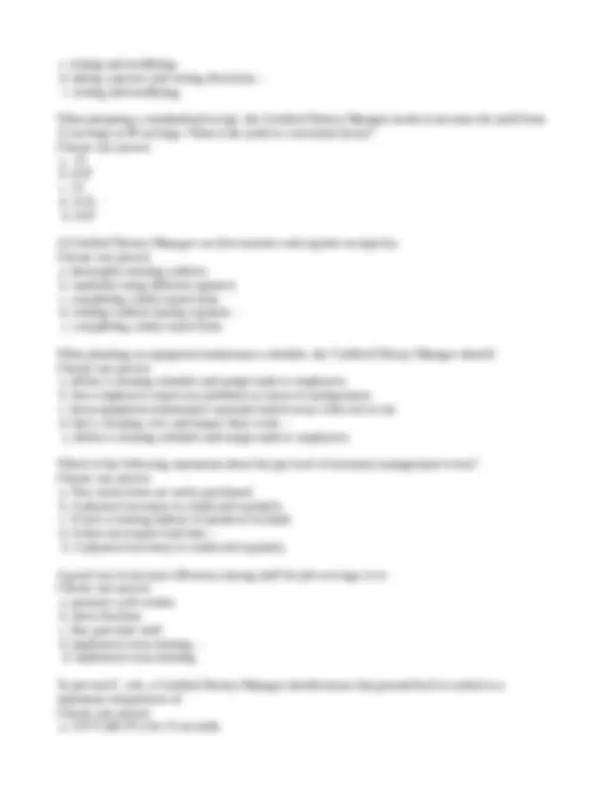
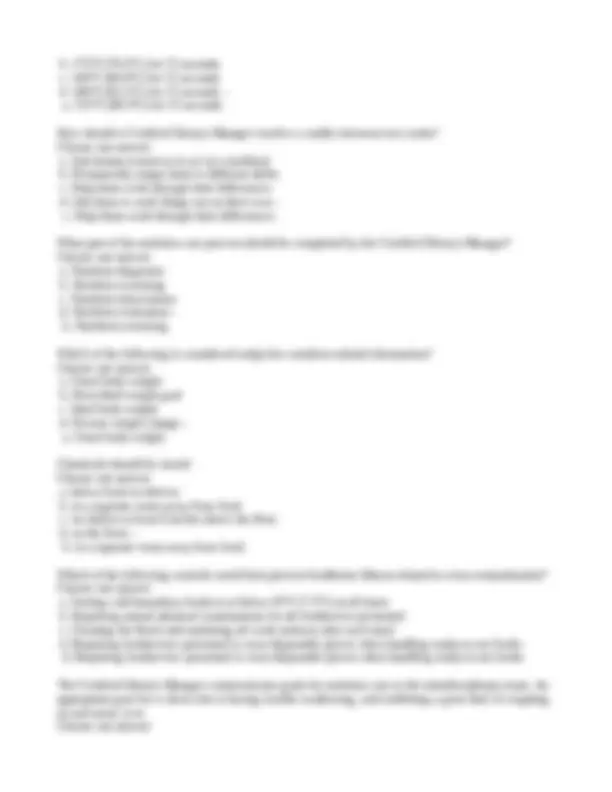
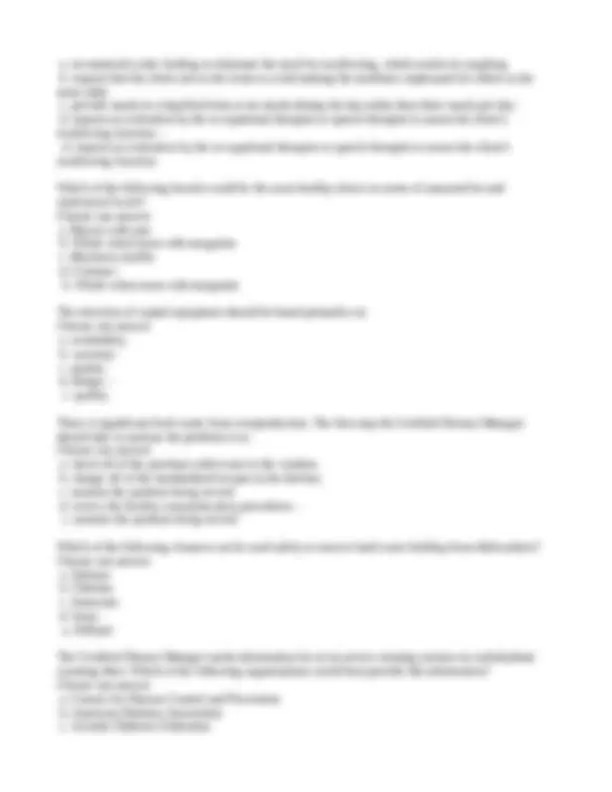
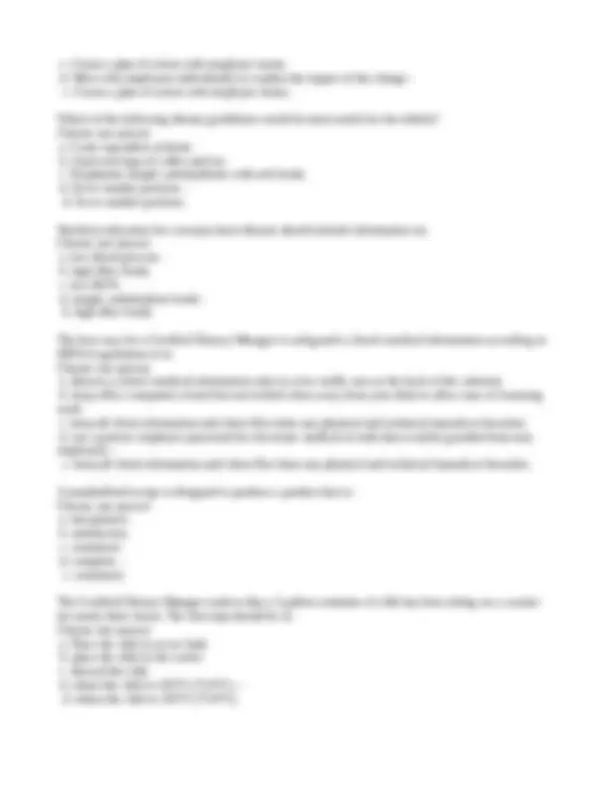
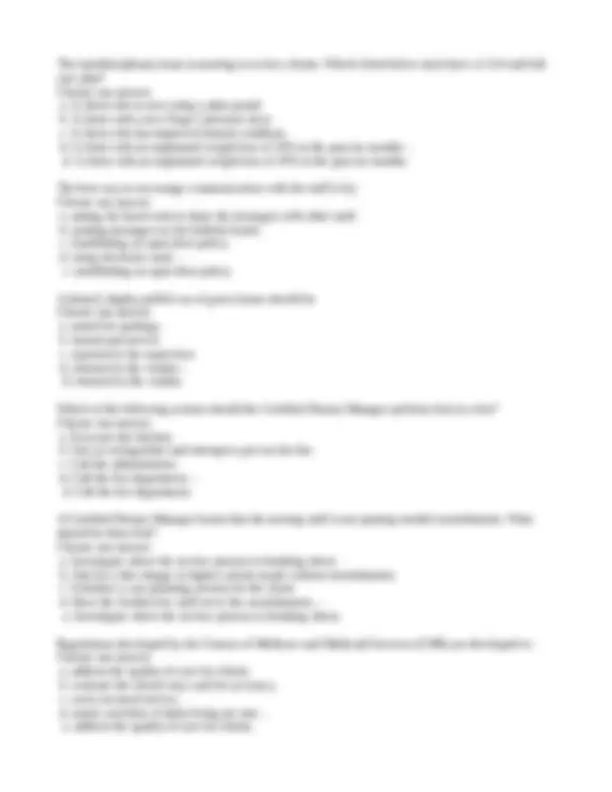
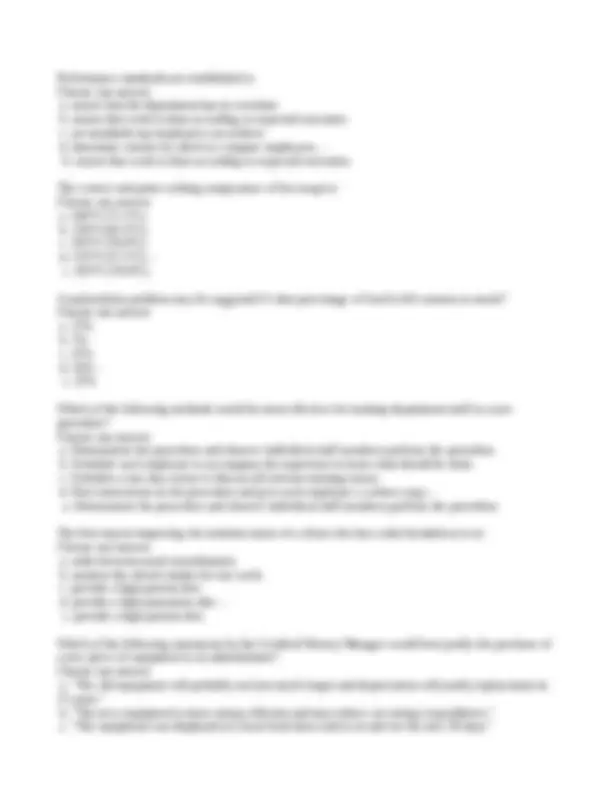
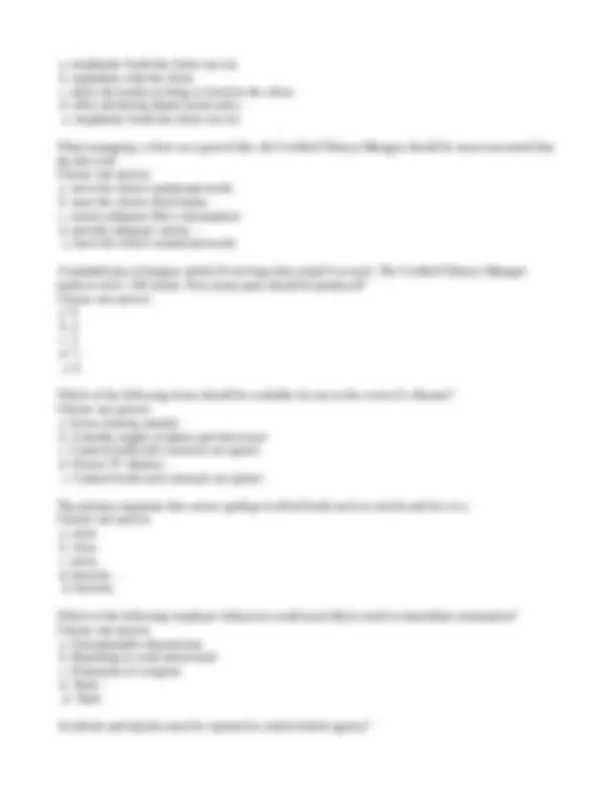
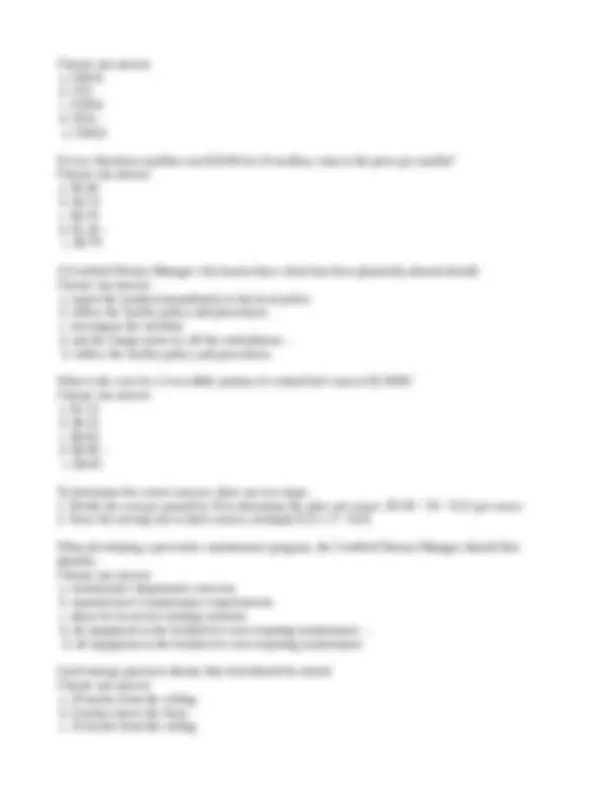
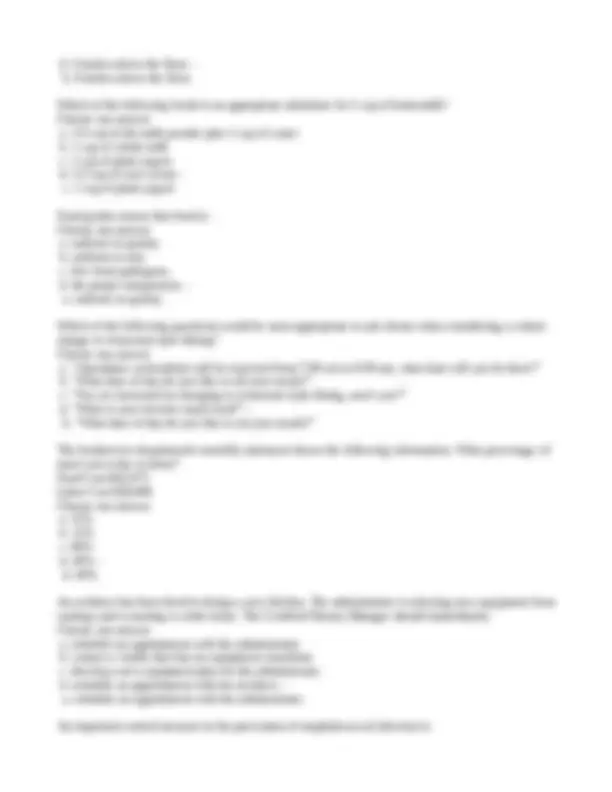
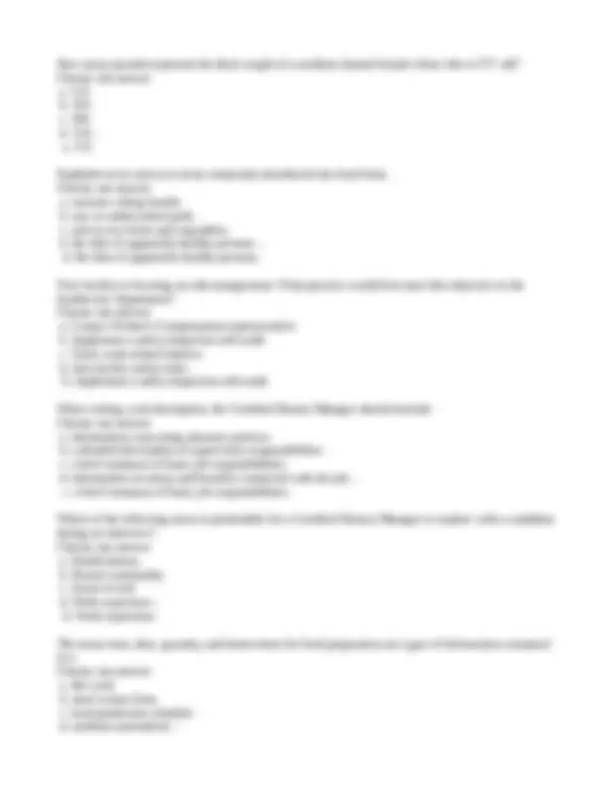
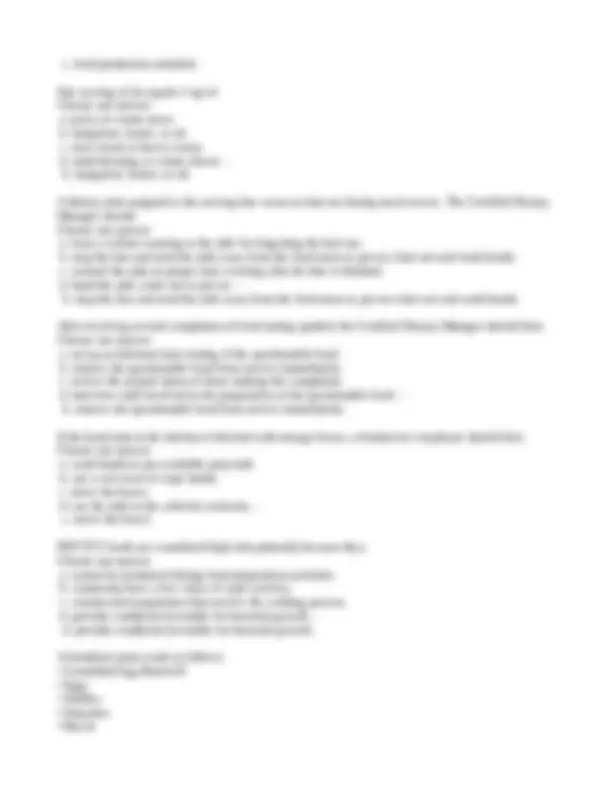
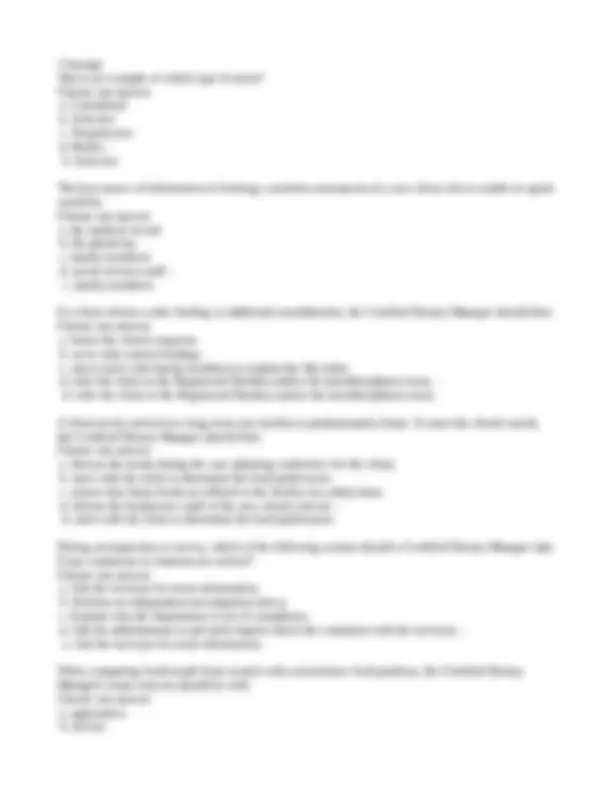
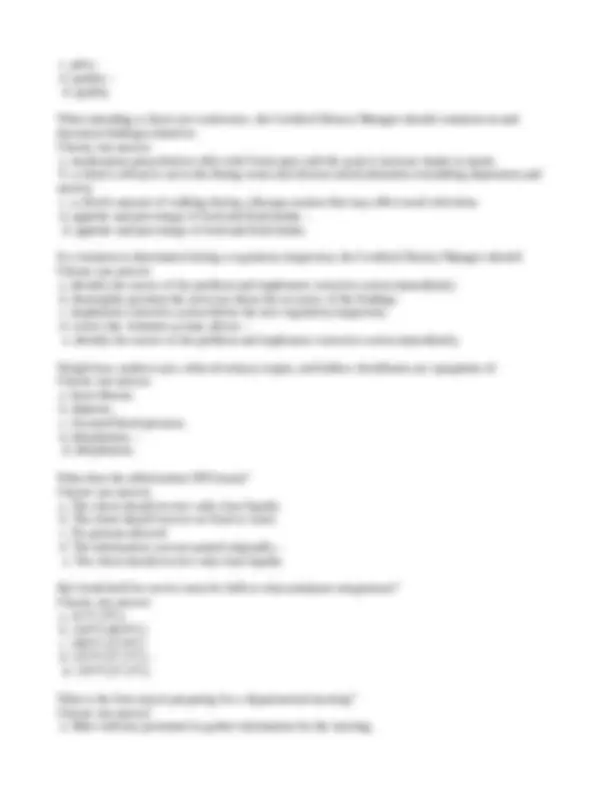
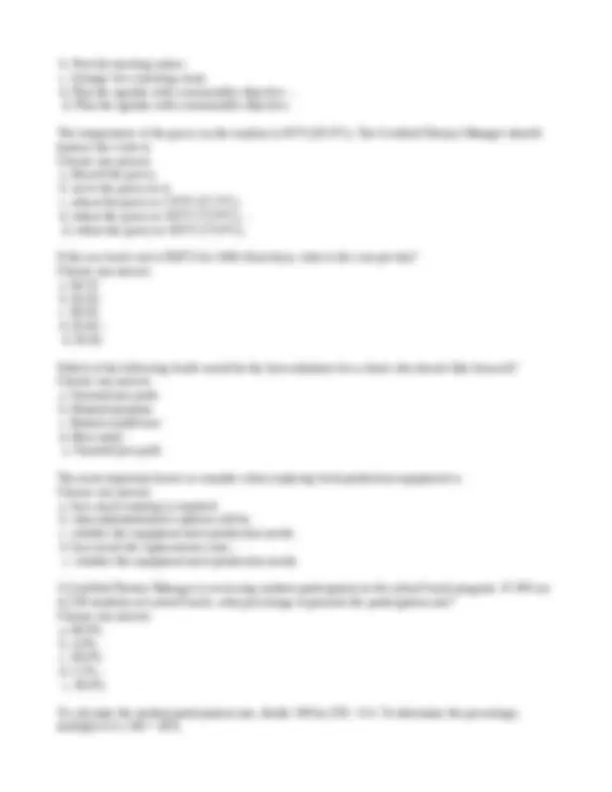
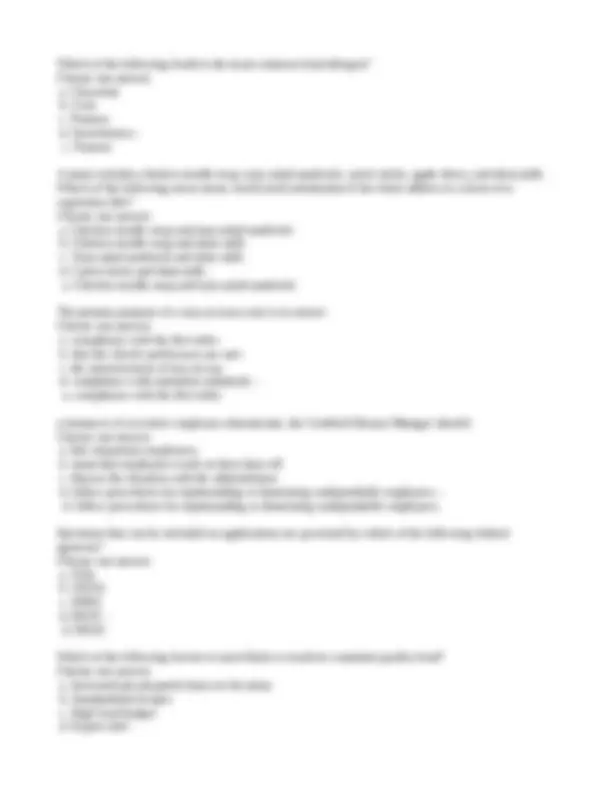
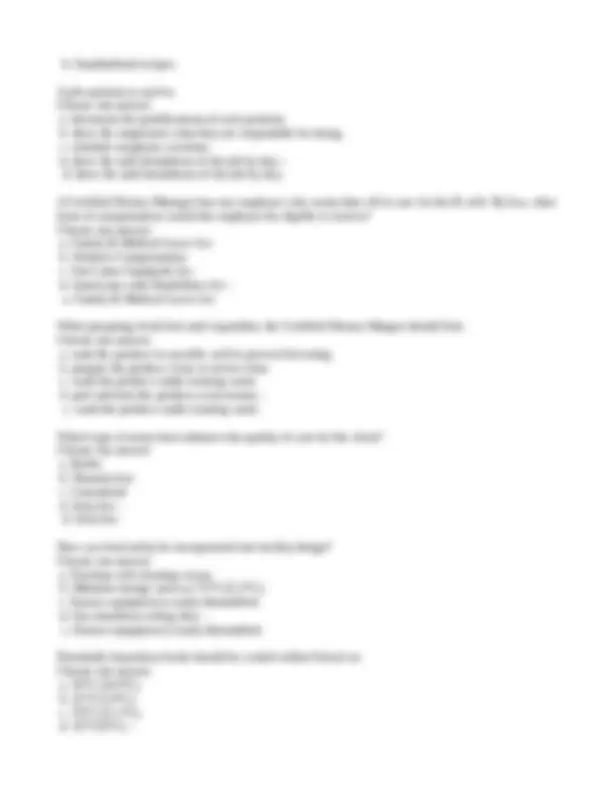
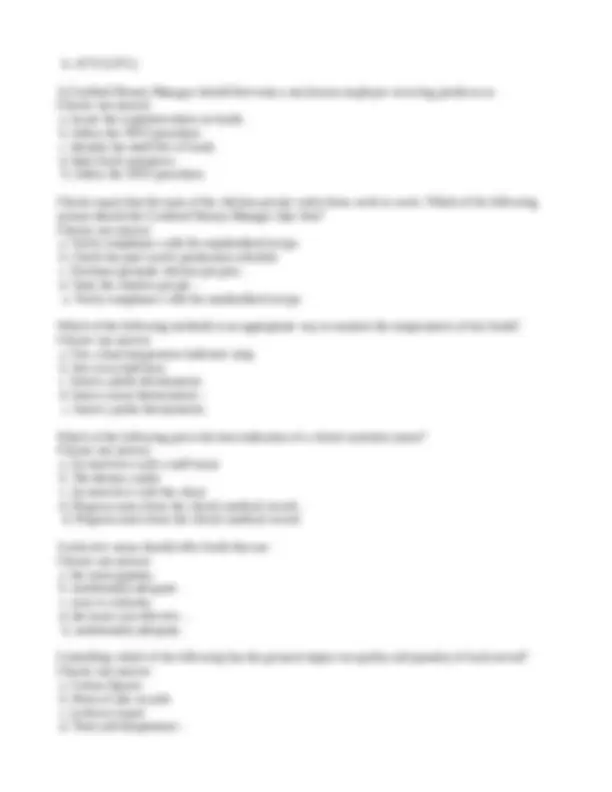
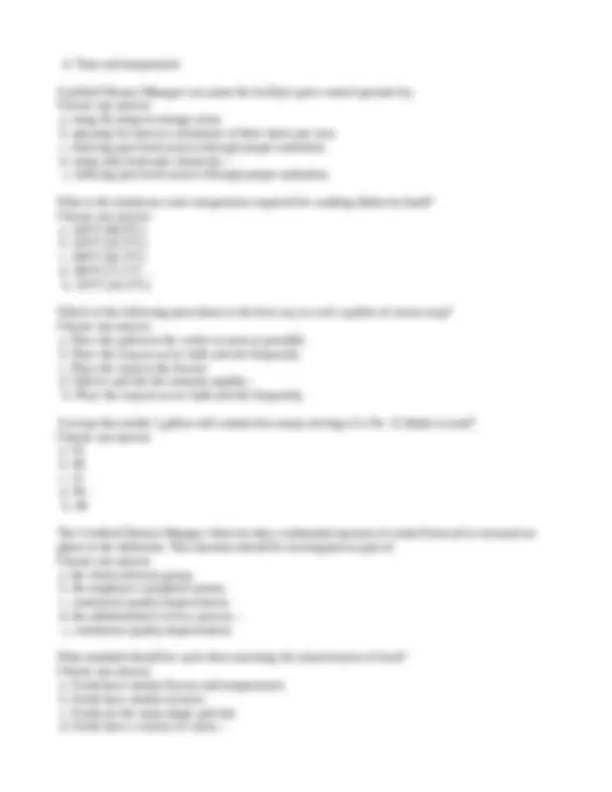
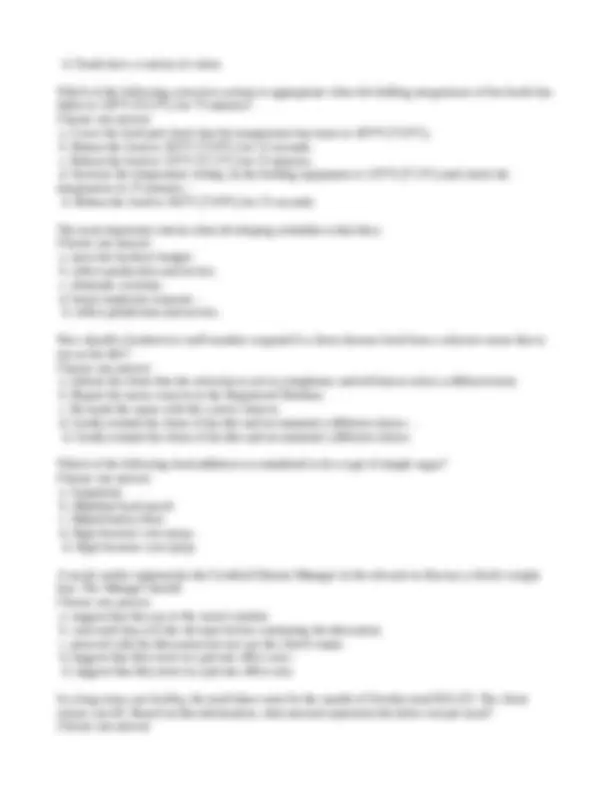

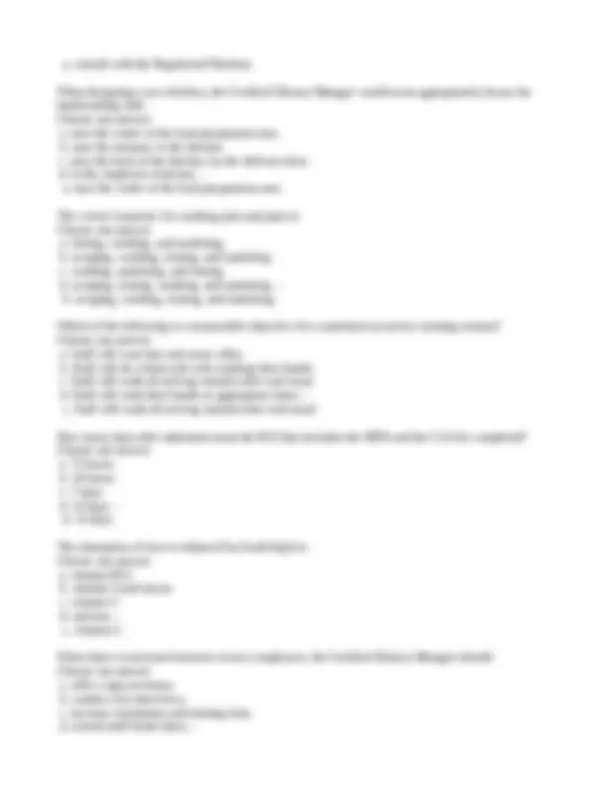
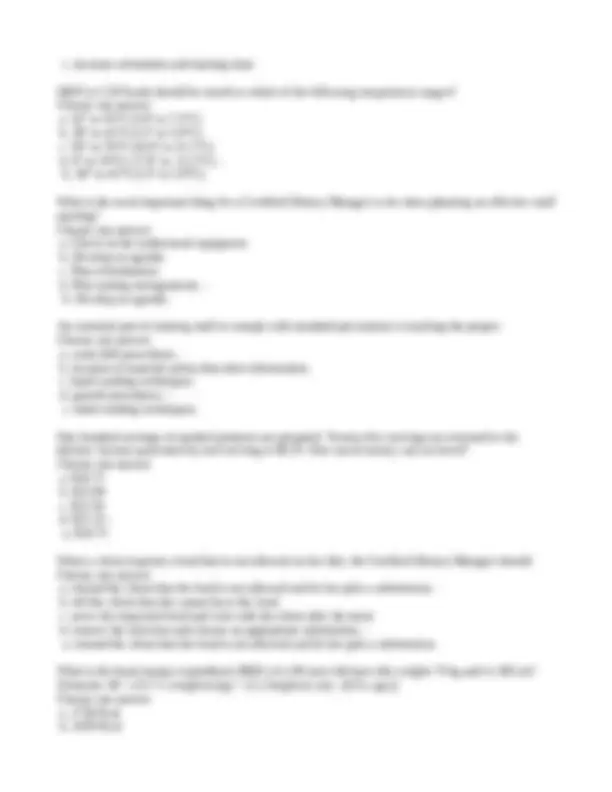
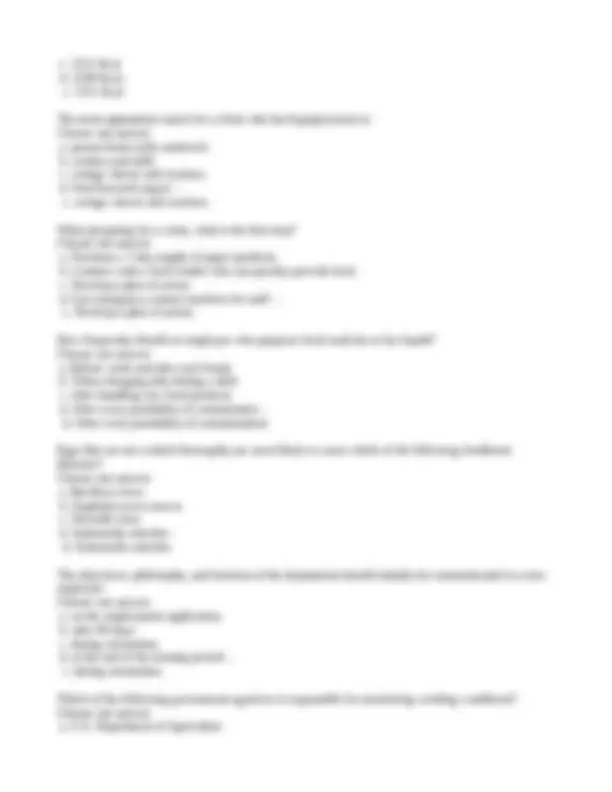
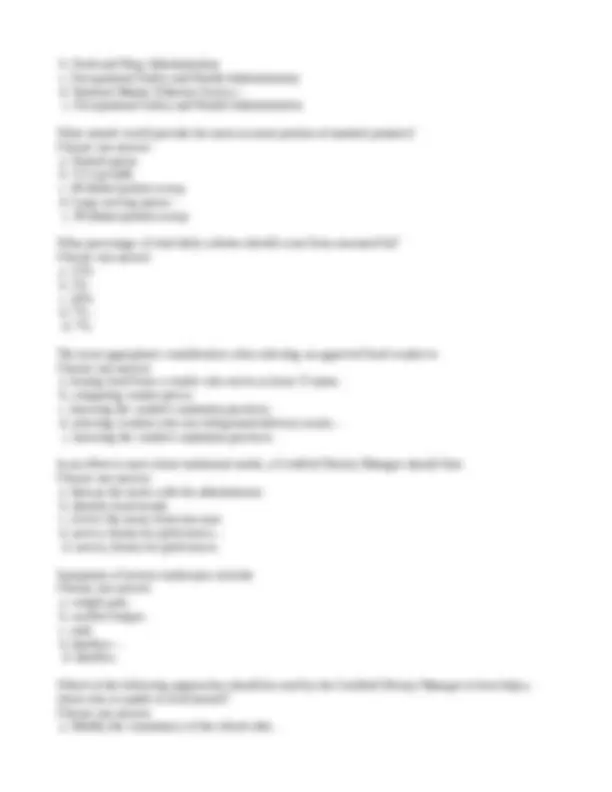
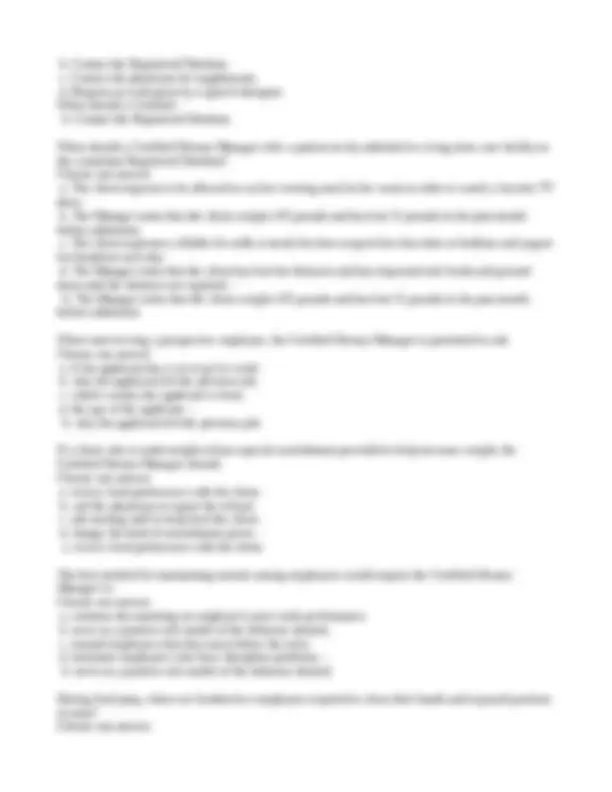
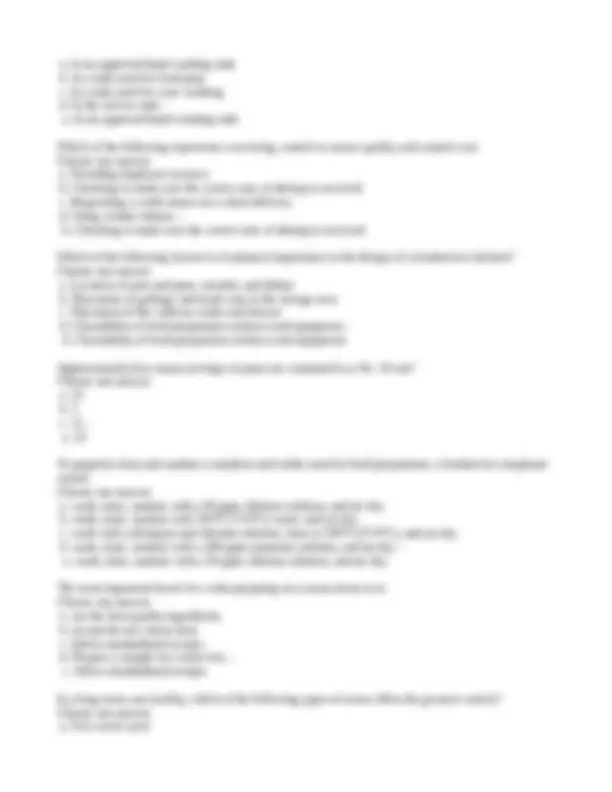
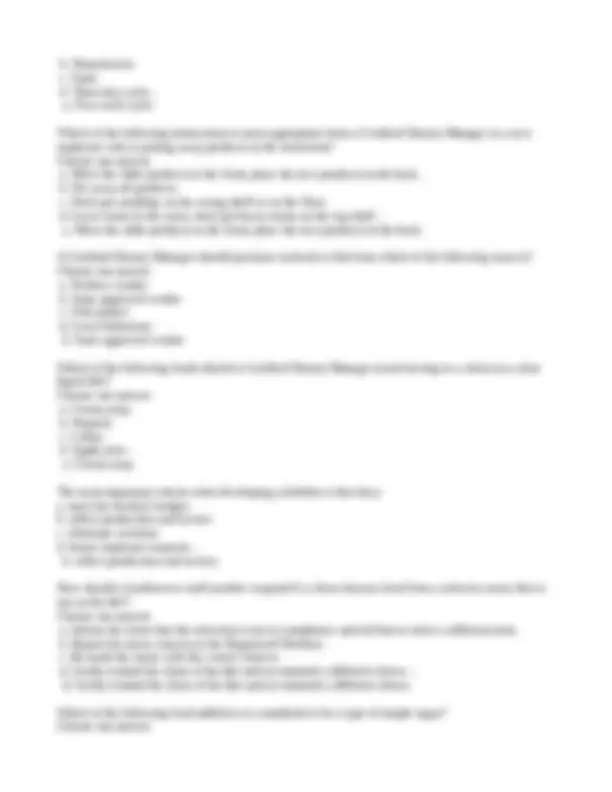
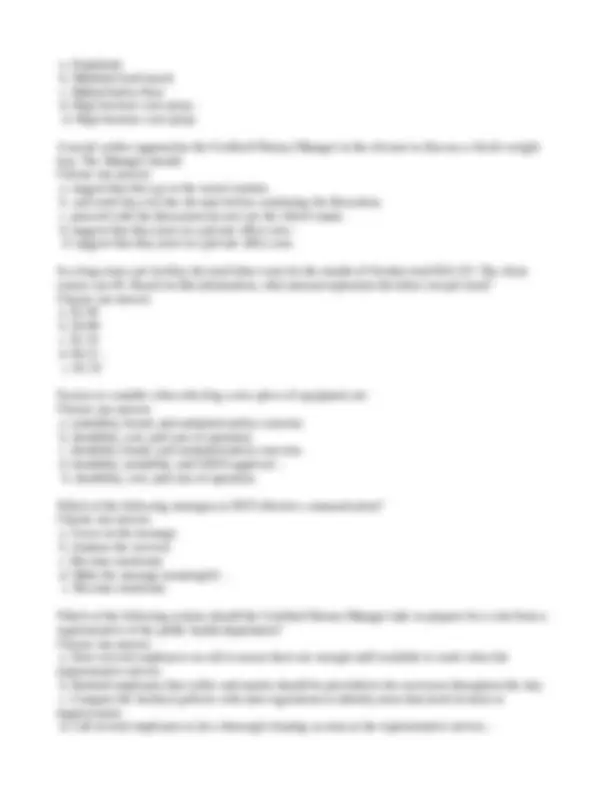
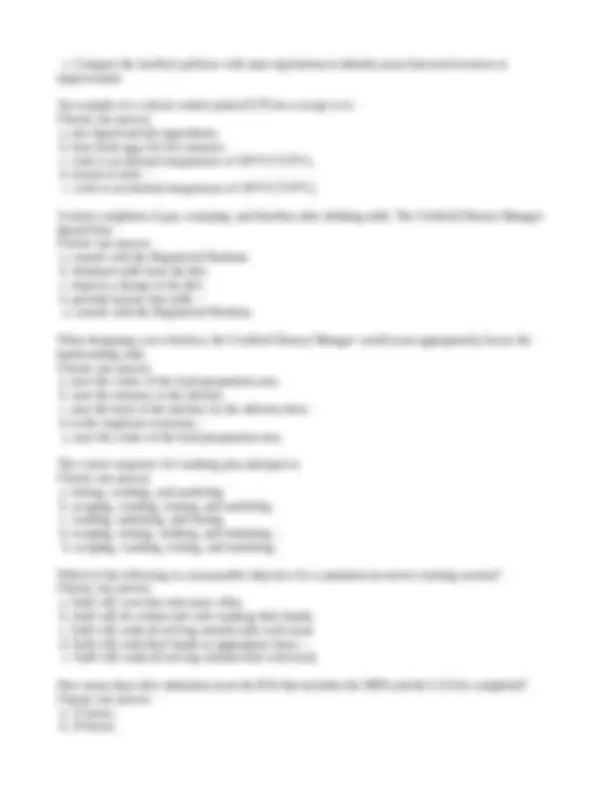
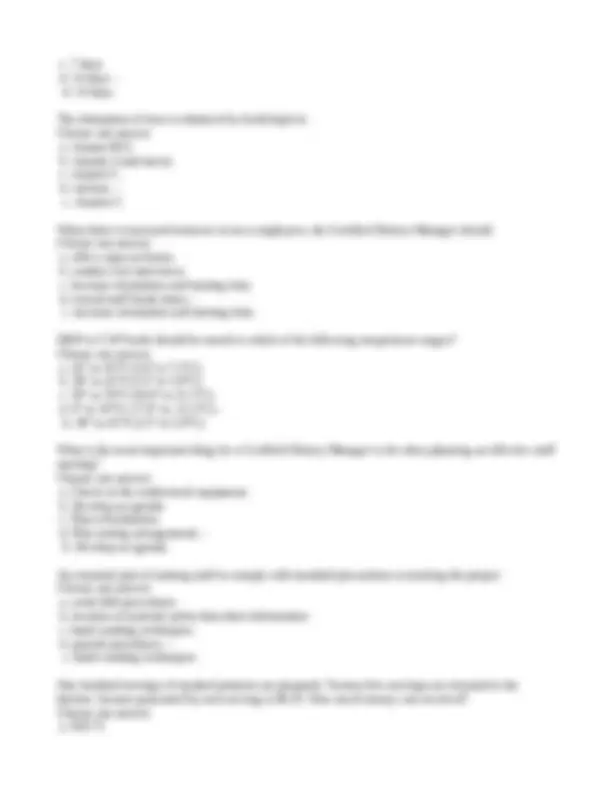
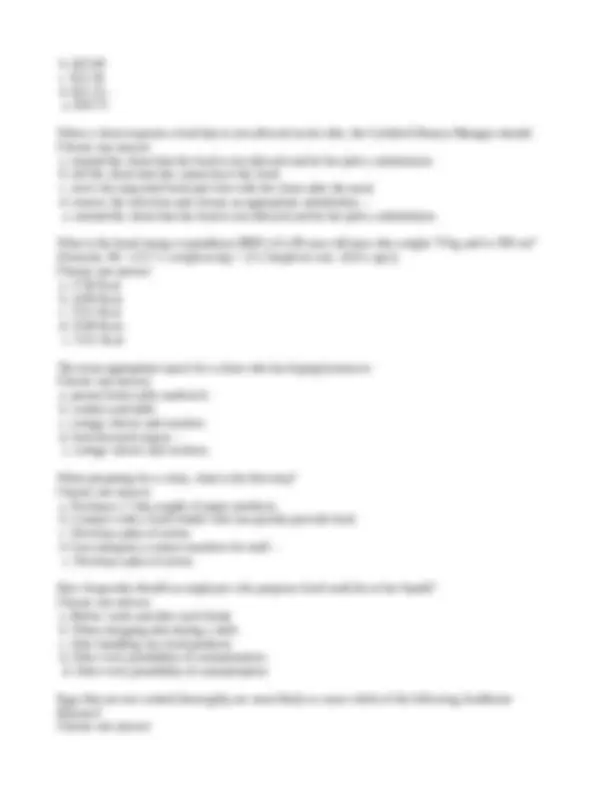
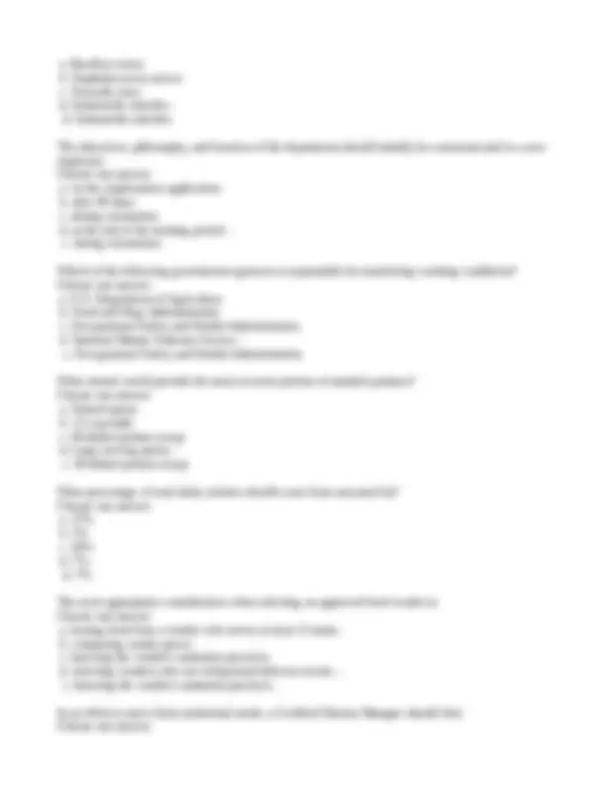
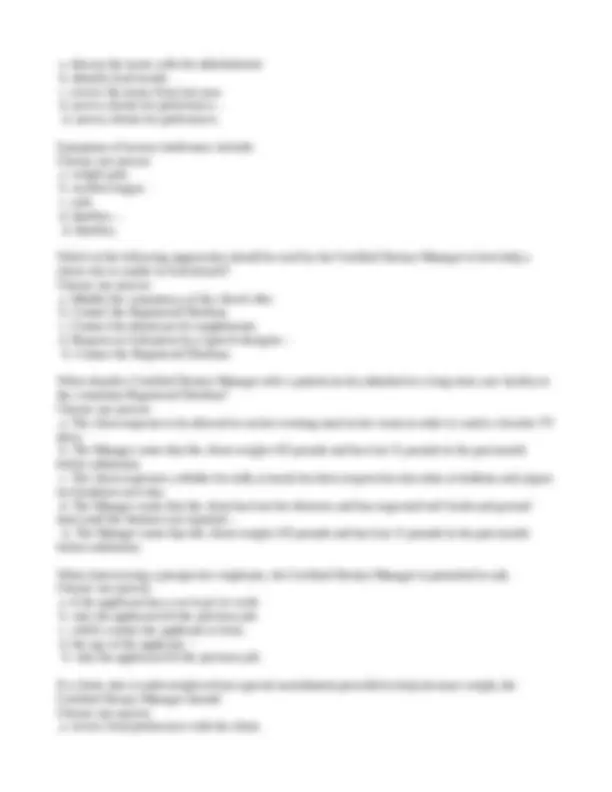
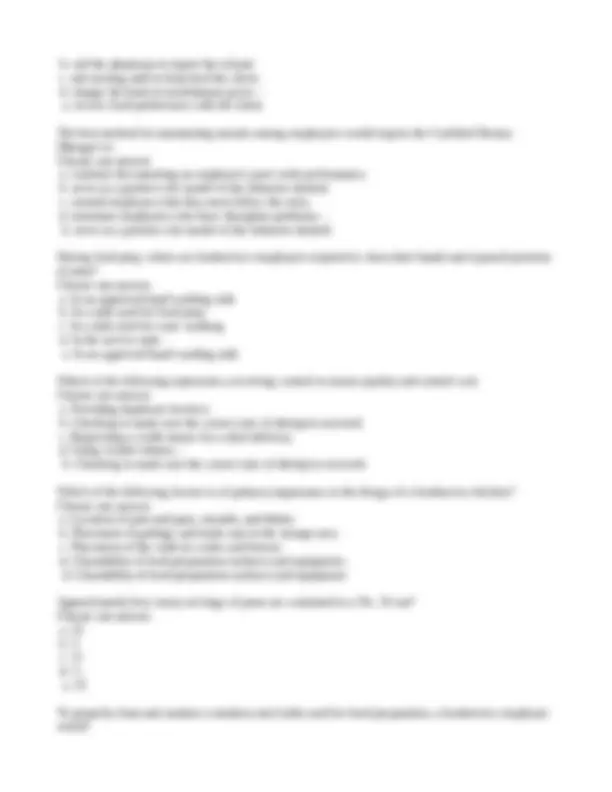
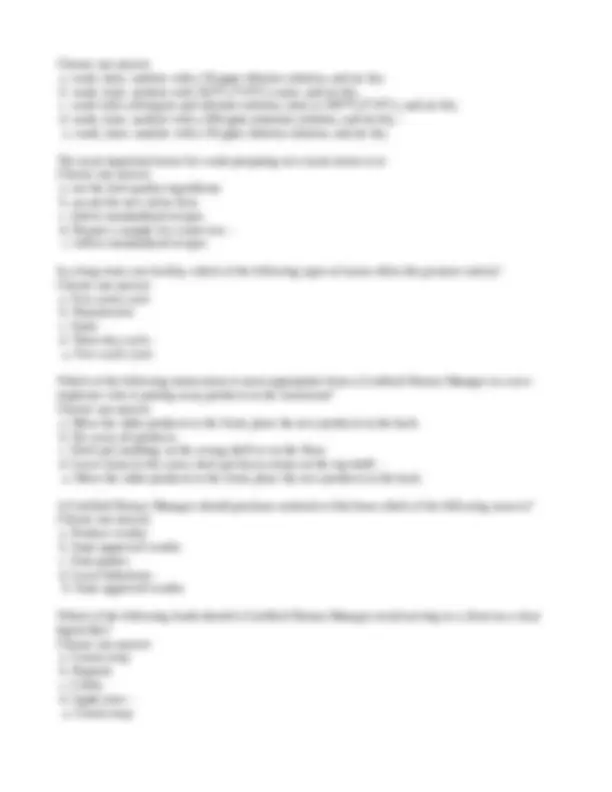
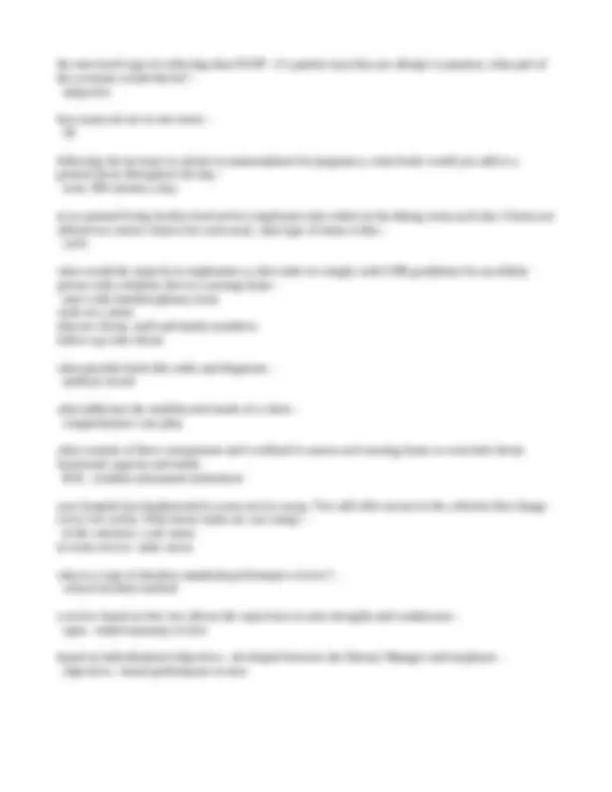


Study with the several resources on Docsity

Earn points by helping other students or get them with a premium plan


Prepare for your exams
Study with the several resources on Docsity

Earn points to download
Earn points by helping other students or get them with a premium plan
Community
Ask the community for help and clear up your study doubts
Discover the best universities in your country according to Docsity users
Free resources
Download our free guides on studying techniques, anxiety management strategies, and thesis advice from Docsity tutors
A study guide for the Certified Dietary Manager Exam. It contains multiple-choice questions and answers related to foodservice management, nutrition, and dietary requirements. The questions cover topics such as vendor management, food preparation, protein substitutes, goal setting, food purchasing, calorie counting, diabetes education, foodborne illnesses, recipe standardization, equipment selection, food waste, employee termination, and job description writing. The guide is intended to help candidates prepare for the exam and improve their knowledge of foodservice management.
Typology: Exams
1 / 44

This page cannot be seen from the preview
Don't miss anything!





































A Certified Dietary Manager is dissatisfied with prices from current vendors. The Manager should first: a. ask vendors to lower their prices. b. ask the consultant to recommend other vendors. c. complete a comparison study of vendors. d. discontinue purchasing from the current vendors. - c. complete a comparison study of vendors. The best way to prepare frozen peas is to: a. slowly cook the peas at 200°F (93.3°C) so they do not dry out. b. cook them rapidly until they reach an internal temperature of 140°F (60.0°C). c. cook them to 120°F (48.9°C) and hold them in the steam table to come up to temperature. d. cook them in batches throughout the service time. - d. cook them in batches throughout the service time. Beans and legumes are essential protein substitutes for clients who are: Choose one answer. a. lactose intolerant. b. vegan. c. ovo-lacto-vegetarian. d. lacto vegetarian. - b. vegan. When preparing goals for the foodservice department, a Certified Dietary Manager must show that the goals are: Choose one answer. a. narrow. b. broad. c. listed on the bulletin board. d. transferrable to other departments. - b. broad. When purchasing food, a Certified Dietary Manager must develop specifications to ensure that: Choose one answer. a. government commodities are used when available. b. eggs are delivered in a timely manner. c. milk arrives at a temperature below 41°F (5°C). d. canned fruits are packed in water or juice. - c. milk arrives at a temperature below 41°F (5°C). When a client has trouble swallowing pureed foods, the Certified Dietary Manager should: Choose one answer. a. request a swallowing evaluation. b. thin foods to straw consistency. c. inform the physician at the next care plan meeting. d. thicken foods to the next consistency level. -
a. request a swallowing evaluation. A calorie count must include: Choose one answer. a. all condiments and beverages served. b. portion sizes of items before consumption. c. initials of the employee documenting the intake. d. how long it took for t - a. all condiments and beverages served. When selecting diabetes educational information for a client in a long-term care facility, a Certified Dietary Manager should consider using materials: Choose one answer. a. written in the English language. b. with technical language to explain the details of the disease. c. in a pocketbook format with small print so it can be kept with the client. d. with simple and relevant illustrations. - d. with simple and relevant illustrations. Which of the following items should NOT be served to a client who is lactose intolerant? Choose one answer. a. Dinner roll b. Buttered carrots c. Chocolate pudding d. Glazed ham - c. Chocolate pudding To effectively prevent foodborne illnesses, the Certified Dietary Manager should most appropriately: Choose one answer. a. remove potentially dangerous food items from the menu. b. provide employees with weekly in-service training. c. monitor time and temperature controls. d. cook all hot foods to an internal temperature of 180°F (82.2°C). - c. monitor time and temperature controls. A Certified Dietary Manager is interviewing a client who recently had a stroke. The client reports painful swallowing, food sticking in her throat, and coughing during meals. The Manager should recognize that these symptoms are indicative of: Choose one answer. a. hiatal hernia. b. gastroesophageal reflux disease (GERD). c. gastritis. d. dysphagia. - d. dysphagia. Two important steps in standardizing a new recipe are: Choose one answer. a. taking a picture and marketing the new menu item. b. testing and garnishing.
b. 175°F (79.4°C) for 15 seconds. c. 140°F (60.0°C) for 15 seconds. d. 180°F (82.2°C) for 15 seconds. - a. 155°F (68.3°C) for 15 seconds How should a Certified Dietary Manager resolve a conflict between two cooks? Choose one answer. a. Ask human resources to act as a mediator. b. Permanently assign them to different shifts. c. Help them work through their differences. d. Ask them to work things out on their own - c. Help them work through their differences. What part of the nutrition care process should be completed by the Certified Dietary Manager? Choose one answer. a. Nutrition diagnosis b. Nutrition screening c. Nutrition intervention d. Nutrition evaluation - b. Nutrition screening Which of the following is considered subjective nutrition-related information? Choose one answer. a. Usual body weight b. Prescribed weight goal c. Ideal body weight d. Percent weight change - a. Usual body weight Chemicals should be stored: Choose one answer. a. below food on shelves. b. in a separate room away from food. c. on shelves at least 6 inches above the floor. d. on the floor. - b. in a separate room away from food. Which of the following controls would best prevent foodborne illiness related to cross-contamination? Choose one answer. a. Storing cold hazardous foods at or below 45°F (7.2°C) at all times b. Requiring annual physical examinations for all foodservice personnel c. Cleaning the floors and sanitizing all work surfaces after each meal d. Requiring foodservice personnel to wear disposable gloves when handling ready-to-eat foods - d. Requiring foodservice personnel to wear disposable gloves when handling ready-to-eat foods The Certified Dietary Manager communicates goals for nutrition care to the interdisciplinary team. An appropriate goal for a client who is having trouble swallowing, and exhibiting a great deal of coughing at each meal, is to: Choose one answer.
a. recommend a tube feeding to eliminate the need for swallowing, which results in coughing. b. request that the client eats in his room to avoid making the mealtime unpleasant for others at the same table. c. provide meals in a liquefied form at six meals during the day rather than three meals per day. d. request an evaluation by the occupational therapist or speech therapist to assess the client's swallowing function. - d. request an evaluation by the occupational therapist or speech therapist to assess the client's swallowing function. Which of the following breads would be the most healthy choice in terms of saturated fat and cholesterol levels? Choose one answer. a. Biscuit with jam b. Whole wheat toast with margarine c. Blueberry muffin d. Croissan - b. Whole wheat toast with margarine The selection of capital equipment should be based primarily on: Choose one answer. a. availability. b. warranty. c. quality. d. design. - c. quality. There is significant food waste from overproduction. The first step the Certified Dietary Manager should take to analyze the problem is to: Choose one answer. a. check all of the purchase orders sent to the vendors. b. change all of the standardized recipes in the kitchen. c. monitor the portions being served. d. review the facility communication procedures. - c. monitor the portions being served. Which of the following cleaners can be used safely to remove hard water buildup from dishwashers? Choose one answer. a. Delimer b. Chlorine c. Ammonia d. Soap - a. Delimer The Certified Dietary Manager needs information for an in-service training session on carbohydrate counting diets. Which of the following organizations would best provide this information? Choose one answer. a. Centers for Disease Control and Prevention b. American Diabetes Association c. Juvenile Diabetes Federation
The Certified Dietary Manager has developed a policy to use disposable products that are environmentally friendly. The facility staff are complaining and refusing to use the products. The Manager should: Choose one answer. a. send an e-mail to all of the supervisors, communicating with the staff that disposable products will not be used. b. stand near the cafeteria serving line to personally communicate to each staff member the benefits of this new product. c. set up a meeting with the facility staff and explain the benefits of the new products. d. collect all of the disposable products left and lock them in the storeroom. - c. set up a meeting with the facility staff and explain the benefits of the new products. To write a job description for the foodservice department, the Certified Dietary Manager should: Choose one answer. a. write the description and job specification with the help of the Registered Dietitian. b. assign the task of writing the job description to the employees who perform the job. c. conduct a job analysis with the help of the head cook and then write the description. d. conduct a job analysis with the help of each employee and then write the job description. - d. conduct a job analysis with the help of each employee and then write the job description. A Certified Dietary Manager may be responsible for completing which of the following sections of the minimum data set (MDS)? Choose one answer. a. Section N b. Section K c. Section L d. Section M - b. Section K A plate-waste study will determine if the food: Choose one answer. a. was accepted by the client. b. was served at the right temperature. c. appears to be fresh. d. served matches the menu selections - a. was accepted by the client. The safest and most sanitary way to taste food is to: Choose one answer. a. use a spoon to dip from the serving ladle and taste. b. have another employee use a clean spoon to give the Certified Dietary Manager a sample taste. c. use a clean finger to taste from the serving ladle. d. ladle a small amount into a dish and taste it with a clean spoon. - d. ladle a small amount into a dish and taste it with a clean spoon. What would be the best way to implement a major change in service for the foodservice department? Choose one answer. a. Post a memo on the department's message board. b. Send employees notifications via e-mail.
c. Create a plan of action with employee teams. d. Meet with employees individually to explain the impact of the change - c. Create a plan of action with employee teams. Which of the following dietary guidelines would be most useful for the elderly? Choose one answer. a. Cook vegetables al dente. b. Limit servings of coffee and tea. c. Emphasize simple carbohydrates with soft foods. d. Serve smaller portions. - d. Serve smaller portions. Nutrition education for coronary heart disease should include information on: Choose one answer. a. low blood glucose. b. high fiber foods c. low BUN. d. simple carbohydrate foods - b. high fiber foods The best way for a Certified Dietary Manager to safeguard a client's medical information according to HIPAA regulations is to: Choose one answer. a. discuss a client's medical information only in a low traffic area at the back of the cafeteria. b. keep office computers closed but not locked when away from your desk to allow ease of resuming work. c. keep all client information and client files from any physical and technical hazards or breaches. d. use a generic employee password for electronic medical records that is safely guarded from non- employees - c. keep all client information and client files from any physical and technical hazards or breaches. A standardized recipe is designed to produce a product that is: Choose one answer. a. inexpensive. b. satisfactory. c. consistent. d. complete. - c. consistent. The Certified Dietary Manager notices that a 5-gallon container of chili has been sitting on a counter for nearly three hours. The first step should be to: Choose one answer. a. Place the chili in an ice bath. b. place the chili in the cooler. c. discard the chili. d. reheat the chili to 165°F (73.9°C). - d. reheat the chili to 165°F (73.9°C).
Performance standards are established to: Choose one answer. a. ensure that the department has no overtime. b. ensure that work is done according to expected outcomes. c. set standards top employees can achieve. d. determine criteria by which to compare employees. - b. ensure that work is done according to expected outcomes. The correct end-point cooking temperature of hot soups is: Choose one answer. a. 160°F (71.1°C). b. 150°F (65.5°C). c. 165°F (76.6°C). d. 135°F (57.2°C). - c. 165°F (76.6°C). A malnutrition problem may be suggested if what percentage of food is left uneaten at meals? Choose one answer. a. 15% b. 5% c. 25% d. 10% - c. 25% Which of the following methods would be most effective for training department staff in a new procedure? Choose one answer. a. Demonstrate the procedure and observe individual staff members perform the procedure. b. Schedule each employee to accompany the supervisor to learn what should be done. c. Schedule a one-day course to discuss all relevant training issues. d. Post instructions on the procedure and give each employee a written copy. - a. Demonstrate the procedure and observe individual staff members perform the procedure. The first step in improving the nutrition status of a client who has a skin breakdown is to: Choose one answer. a. order between-meal nourishments. b. monitor the client's intake for one week. c. provide a high-protein diet. d. provide a high-potassium diet. - c. provide a high-protein diet. Which of the following statements by the Certified Dietary Manager would best justify the purchase of a new piece of equipment to an administrator? Choose one answer. a. "The old equipment will probably not last much longer and depreciation will justify replacement in 15 years." b. "The new equipment is more energy efficient and may reduce our energy expenditures." c. "The equipment was displayed at a local food show and is on sale for the next 30 days."
d. "Repair costs for the present equipment will be more than half the cost of replacement." - d. "Repair costs for the present equipment will be more than half the cost of replacement." In a dry-food storeroom, which of the following situations is NOT acceptable? Choose one answer. a. Room temperature ranging between 50° and 70°F (10.0° and 21.1°C) b. An area dedicated for chemicals c. Adequate ventilation and air circulation d. Slatted or louvered shelves - b. An area dedicated for chemicals What financial document would you use to view the department's monthly performance with what was budgeted? Choose one answer. a. Operating statement b. Budget c. Profit and loss statement d. Balance sheet - a. Operating statement What is the most important reason for following posted menus? Choose one answer. a. The client may want to invite guests. b. Staff will know their production assignments. c. Food costs can be kept in line. d. Posted menus must match what is served. - d. Posted menus must match what is served. Which of the following characteristics is altered for a mechanical soft diet? Choose one answer. a. Flavor b. Texture c. Color d. Aroma - b. Texture Which of the following cooking methods is best for retaining the nutritional value of vegetables? Choose one answer. a. Grilling b. Boiling c. Simmering d. Steaming - d. Steaming A Certified Dietary Manager is following the hazard communication standard when she provides which of the following items for employees? Choose one answer. a. Latex-free gloves b. Safety glasses
a. emphasize foods the client can eat. b. empathize with the client. c. allow the family to bring in food for the client. d. offer salt during dinner meals only. - a. emphasize foods the client can eat. When managing a client on a pureed diet, the Certified Dietary Manager should be most concerned that the diet will: Choose one answer. a. meet the client's nutritional needs. b. meet the client's fluid intake. c. ensure adequate fiber consumption. d. provide adequate variety. - a. meet the client's nutritional needs. A standard pan of lasagna yields 24 servings that weigh 6 oz each. The Certified Dietary Manager needs to serve 138 clients. How many pans should be produced? Choose one answer. a. 6 b. 4 c. 5 d. 7 - a. 6 Which of the following items should be available for use in the event of a disaster? Choose one answer. a. Extra cooking utensils b. A double supply of plates and silverware c. Canned foods and a manual can opener d. Frozen TV dinners - c. Canned foods and a manual can opener The primary organism that causes spoilage in dried foods such as cereals and rice is a: Choose one answer. a. yeast. b. virus. c. toxin. d. bacteria. - d. bacteria. Which of the following employee behaviors would most likely result in immediate termination? Choose one answer. a. Unexplainable absenteeism b. Reporting to work intoxicated c. Possession of weapons d. Theft - d. Theft Accidents and injuries must be reported to which federal agency?
Choose one answer. a. OSHA b. FTC c. USDA d. FDA - a. OSHA If 4-oz. blueberry muffins cost $18.96 for 24 muffins, what is the price per muffin? Choose one answer. a. $0. b. $4. c. $0. d. $1.26 - c. $0. A Certified Dietary Manager who learns that a client has been physically abused should: Choose one answer. a. report the incident immediately to the local police. b. follow the facility policy and procedures. c. investigate the incident. d. ask the charge nurse to call the ombudsman. - b. follow the facility policy and procedures. What is the cost for a 3-oz edible portion of cooked beef roast at $3.36/lb? Choose one answer. a. $1.12. b. $0.21. c. $0.63. d. $0.99. - c. $0.63. To determine the correct answer, there are two steps:
Choose one answer. a. exclusion from food handling if an employee has a respiratory infection. b. continually changing disposable gloves after each task. c. isolating raw food from cooked food. d. dividing large batches of food into smaller batches for rapid refrigeration. - a. exclusion from food handling if an employee has a respiratory infection. It is most important that separate cuttings boards be used for: Choose one answer. a. raw turkey and raw chicken. b. raw pork and raw beef. c. raw chicken and lettuce. d. tomatoes and pepperoni. - c. raw chicken and lettuce. The temperature of meatloaf that has been baking for 45 minutes registers 140°F (60.0°C). The cook should: Choose one answer. a. cook the meatloaf for an additional 30 minutes. b. cook the meatloaf until the temperature reaches 150°F (65.6°C) for 15 seconds. c. hold the meatloaf at that temperature. d. cook the meatloaf until the temperature reaches 165°F (73.9°C) for 15 seconds. - d. cook the meatloaf until the temperature reaches 165°F (73.9°C) for 15 seconds. Which of the following is a major category of a foodservice department budget? Choose one answer. a. Overhead b. Supplements c. Labor d. Chemicals - c. Labor When is the Certified Dietary Manager required to pay overtime? Choose one answer. a. When employees work a regular day off. b. When employees work holidays. c. When employees work night and weekend shifts. d. When employees have worked in excess of 40 hour - d. When employees have worked in excess of 40 hour The Certified Dietary Manager should insist that food be prepared to retain color, aroma, texture, and: Choose one answer. a. shape. b. flavor. c. moisture. d. vitamin C. - b. flavor. Which of the following items are among the most common food allergens?
Choose one answer. a. Fish and shellfish b. Yogurt and cheese c. Fruit juice and alcohol d. Strawberries and melons - a. Fish and shellfish A Certified Dietary Manager can best ensure compliance with safe food preparation practices by: Choose one answer. a. implementing disciplinary action for noncompliance. b. excluding all infected employees from food handling tasks. c. combining supervision with continuous training. d. asking employees to monitor food temperatures. - c. combining supervision with continuous training. What is the main purpose of using a screening process to select appliants for interviewing? Choose one answer. a. Obtain additional information b. Check references c. Follow uniform guidelines for employee selection d. Predict how well a candidate will perform - c. Follow uniform guidelines for employee selection Which of the following is necessary for addressing the multiple needs of a client? Choose one answer. a. Meet with the interdisciplinary team. b. Perform a physical assessment. c. Identify diagnostic tests. d. Observe the client during mealtimes. - a. Meet with the interdisciplinary team. What food should be selected to lower saturated fat and cholesterol in cream soups? Choose one answer. a. 2% milk b. 1% milk c. Evaporated milk d. Whole milk - b. 1% milk A client who is admitted to a long-term care facility practices Orthodox Judaism. On the dinner menu, pork chops, rice pilaf, broccoli, and apple crisp will be served. Which of the following foods need to be substituted to meet the client's dietary requirements? Choose one answer. a. Apple crisp b. Pork chop c. Broccoli d. Rice pilaf - b. Pork chop
c. food production schedule. One serving of fat equals 1 tsp of: Choose one answer. a. gravy or cream sauce. b. margarine, butter, or oil. c. sour cream or heavy cream. d. salad dressing or cream cheese. - b. margarine, butter, or oil. A dietary aide assigned to the serving line wears no hair net during meal service. The Certified Dietary Manager should: Choose one answer. a. issue a written warning to the aide for forgetting the hair net. b. stop the line and send the aide away from the food areas to put on a hair net and wash hands. c. counsel the aide on proper hair covering after the line is finished, d. hand the aide a hair net to put on. - b. stop the line and send the aide away from the food areas to put on a hair net and wash hands. After receiving several complaints of food tasting spoiled, the Certified Dietary Manager should first: Choose one answer. a. set up an informal taste testing of the questionable food. b. remove the questionable food from service immediately. c. review the mental status of those making the complaints. d. interview staff involved in the preparation of the questionable food. - b. remove the questionable food from service immediately. If the hand sink in the kitchen is blocked with storage boxes, a foodservice employee should first: Choose one answer. a. wash hands in any available prep sink. b. use a wet towel to wipe hands. c. move the boxes. d. use the sink in the cafeteria restroom. - c. move the boxes. PHF/TCS foods are considered high risk primarily because they: Choose one answer. a. cannot be monitored during food preparation activities. b. commonly have a low value of water activity. c. contain microorganisms that survive the cooking process. d. provide conditions favorable for bacterial growth. - d. provide conditions favorable for bacterial growth. A breakfast menu reads as follows: